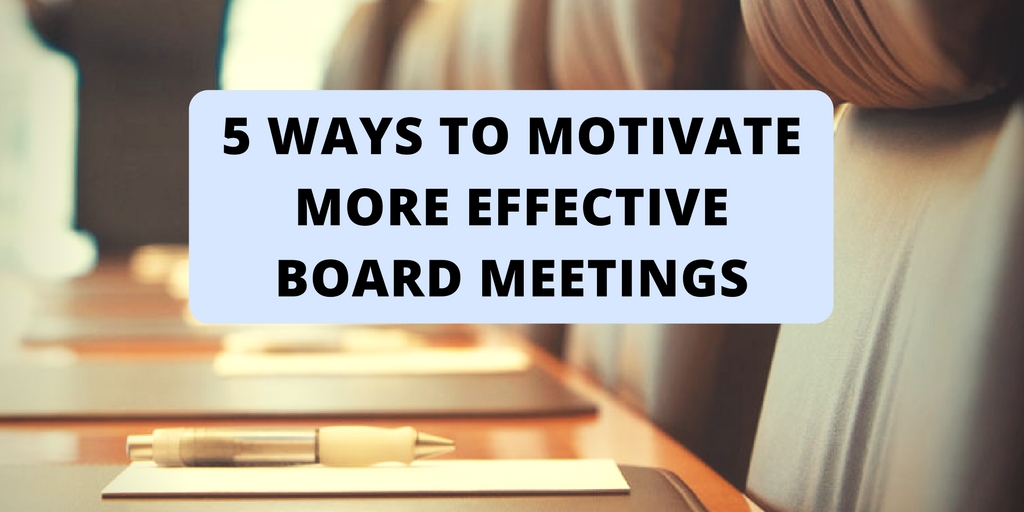5 Ways to Motivate More Effective Board Meetings
 The “life” of a non-profit board exists in its official meetings. The time that a board has to experience this “life” is extremely limited (perhaps 30-40 hours each year), which means that board leaders have to plan meetings that enable the board to derive the most value during these scheduled interactions. Ineffective meetings—those that hinder a board’s ability to advance the agency’s mission by making good decisions—generate board dysfunction and affect the health of the agency. So investing wisdom in developing quality meetings and board experiences pays immense dividends.
The “life” of a non-profit board exists in its official meetings. The time that a board has to experience this “life” is extremely limited (perhaps 30-40 hours each year), which means that board leaders have to plan meetings that enable the board to derive the most value during these scheduled interactions. Ineffective meetings—those that hinder a board’s ability to advance the agency’s mission by making good decisions—generate board dysfunction and affect the health of the agency. So investing wisdom in developing quality meetings and board experiences pays immense dividends.
Experienced, non-profit board leaders rely upon five key principles to ensure that their board meetings are productive and healthy:
1. Leverage the link between meetings and mission
Understand the essential relationship between effective board meetings and achieving the key outcomes necessary to advance the mission. When board leaders and the CEO fail to perceive the inter-relationship between well-planned board interactions and the ability of the agency to fulfill its vision, then insufficient attention will be given to nurturing the “life” of the board. The inevitable result will be poor planning, mediocre leadership, and risky decisions.
2. Develop an annual agenda
Board leaders serve the board and its members. This can only happen if board leaders understand the role and responsibility of the board, have a clear perception of the work that the board has to accomplish annually, and know how to pace the work of the board to fulfill its responsibilities effectively and efficiently. Developing an annual agenda will accomplish these purposes in the following ways:
- It will ensure that time-sensitive decisions are scheduled appropriately
- It will require the board to have the necessary information in hand to make such decisions
- It will empower the board to handle unanticipated issues without upsetting its rhythm
Effective board leaders understand the culture of their board and know how to guide the board’s “life-in-meetings” to take full advantage of this culture to enable good discussion and timely decisions. Where this culture demonstrates some weaknesses, board leaders will find ways to educate, challenge, and change board culture for the better. Two important tools that assist this leadership would be: a board code of conduct and an annual assessment of the board’s work. These two policy tools enable board leaders to structure high-energy engagement with issues and be a catalyst for board development and change based upon the board’s own insights. In addition, the board should develop a position description for the board chair that empowers this individual to guide the board well in these matters.
4. Spend meeting time on the future
Board leaders have to plan the interactions between the CEO and the board effectively. The reports produced by the CEO are significant tools by which the board discerns how past actions are moving the agency to achieve defined, key results. However, time spent in the board meeting reviewing the past should be limited. Similarly, the board has to have its finger on the present pulse of the organization and here again the CEO’s reports offer critical information regarding the board’s “worry-points.” The board agenda will probably have to give some time to resolving current issues, but these should be managed through recommendations provided by standing committees or short-term task forces. The bulk of the board’s time and energy in each meeting should be devoted to the future. Wise board leaders continue to ask themselves which agenda items will advance the mission and they ensure these items get the best and most time in the board meeting. Using tools such as consent agendas, discussion briefs, decision proposals, etc. help boards make the best use of their time. It is also helpful to ensure that CEO reports are circulated in writing at least one week before the meeting so board members can read and digest the information. Such reports should not be read during meetings. A consent agenda gives space for board members to ask questions and identify issues that need future board attention.
5. Document every decision
Wise board leaders foster the “life” of a non-profit board by ensuring that all decisions are recorded accurately in minutes that the board carefully reviews. Once approved, these minutes need to be signed by the board chair to indicate their official nature. All board members must have access to all board minutes. This record becomes the official “voice” of the board, defining its decisions and preventing board members or staff acting arbitrarily based upon “memory.”
If you are a non-profit board leader in a church or other Christian agency, take the time and make the investment to plan the “life” of the board well. It is the only way to enable your board to operate effectively and to use well the spiritual intelligence God has provided through each board person for the benefit of the agency.
This blog entry was written by Dr. Larry Perkins and is based on the presentation he delivered during MinistryLift's Building Healthy Boards series. This article and hundreds of other church board resources can be found on his website, ChurchBoardChair.ca. Dr. Perkins is Professor of Biblical Studies at Northwest Baptist Seminary and he serves as an elder at SouthRidge Fellowship Baptist Church in Langley, BC.
